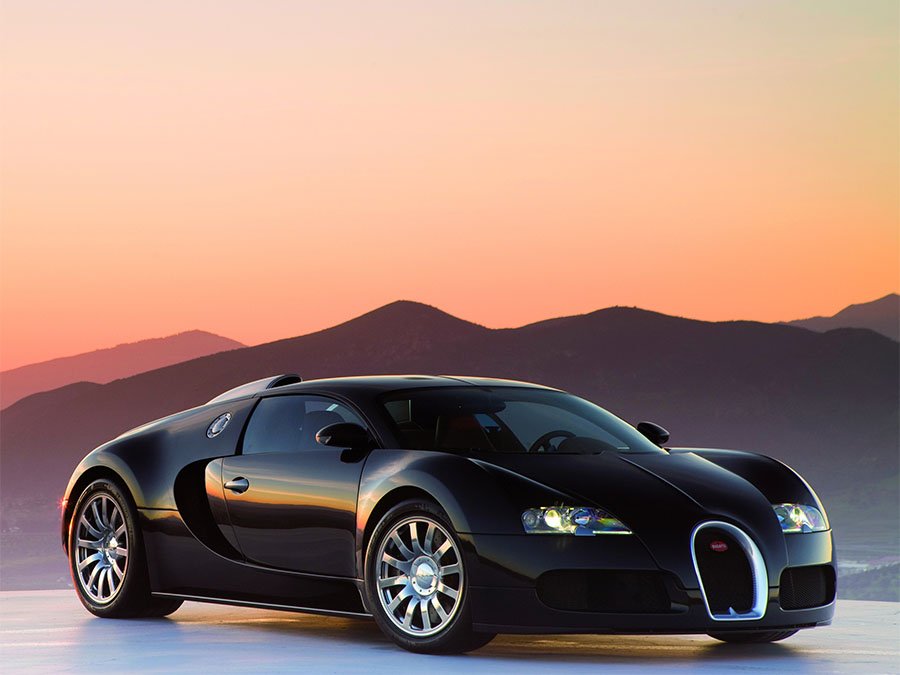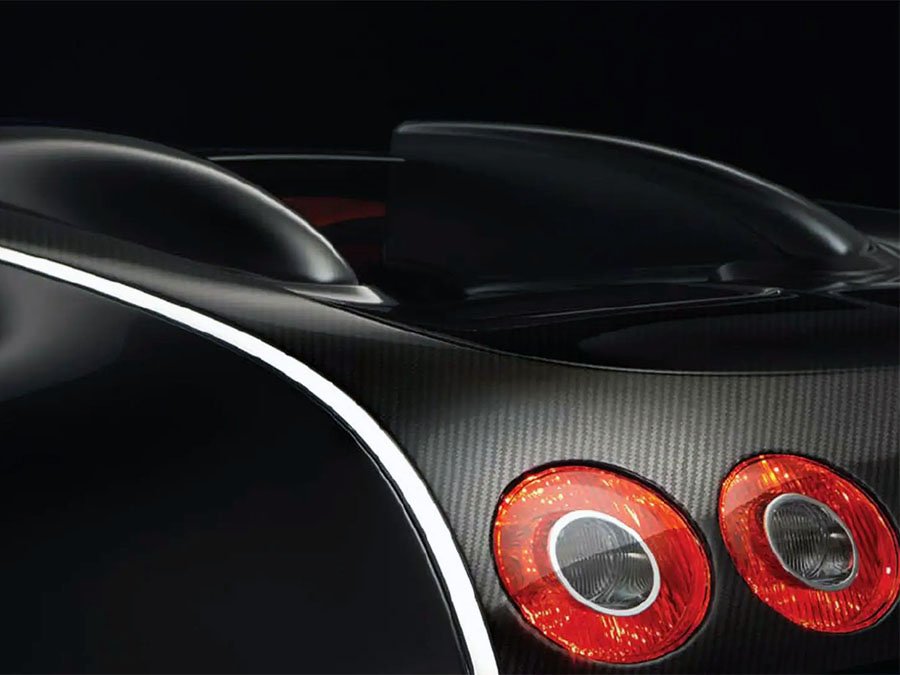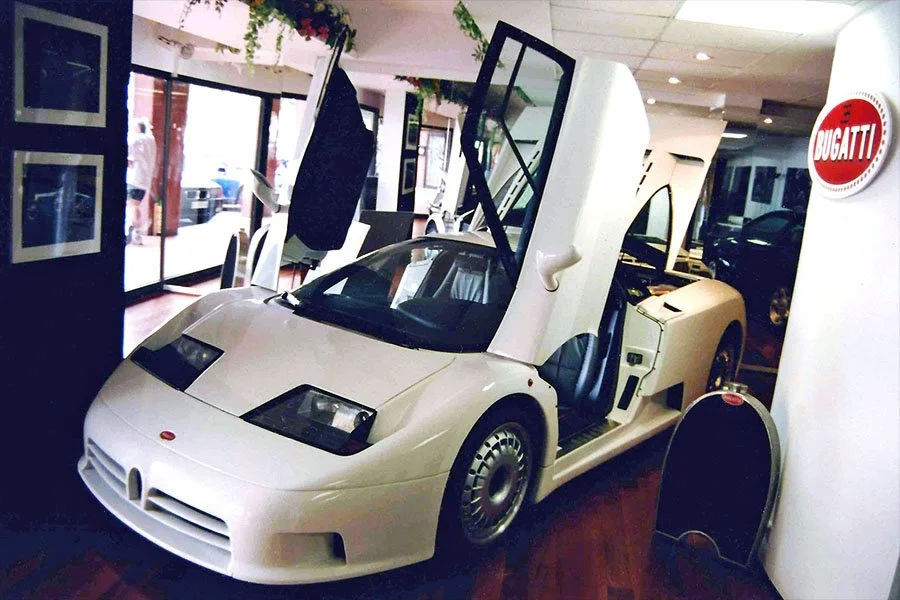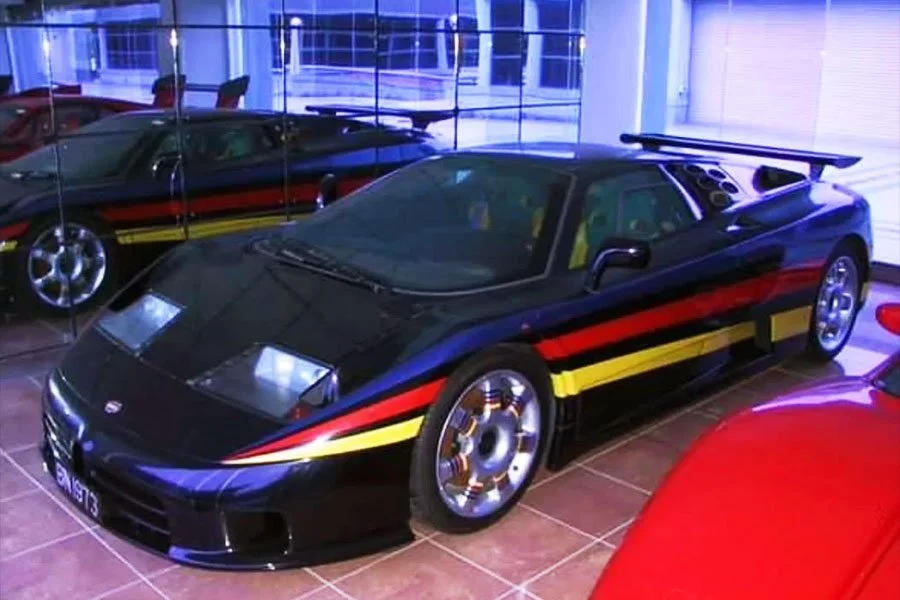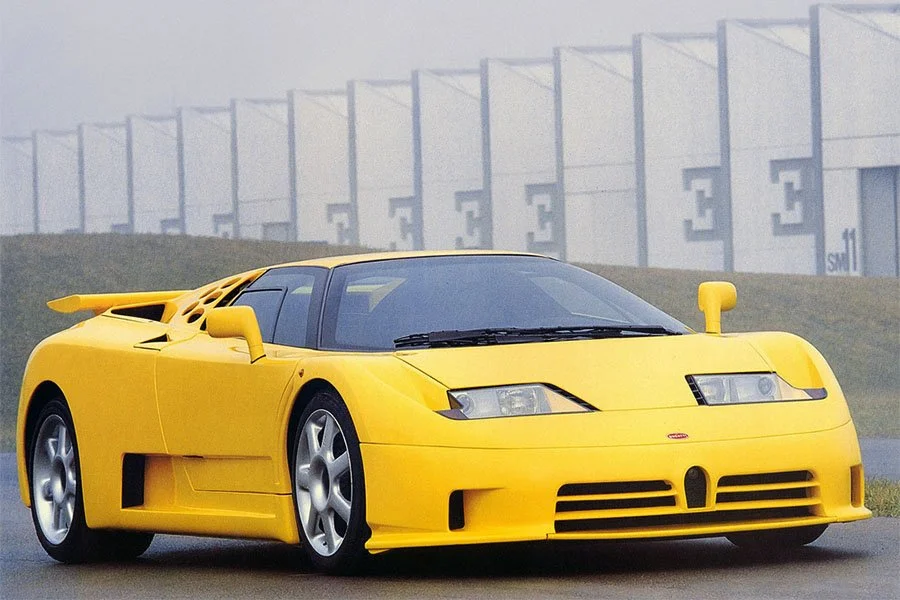Guide: Bugatti 16.4 Veyron - a Historical & Technical Appraisal
/BACKGROUND
16 months after the Volkswagen Audi Group (VAG) purchased the rights to Bugatti at the behest of their Chairman, Ferdinand Piech, prototypes for an extravagantly engineered super sports car began to emerge.
First to arrive was the Ital Design 18.3 Chiron at the Frankfurt Motor Show in September 1999. The Chiron concept was then quickly overshadowed by the in-house styled 18.4 Veyron that took the Tokyo Motor Show by storm in October 1999.
However, by the time the Veyron broke cover in the Far East, Volkswagen’s engineers were already beginning to experience the first of myriad weight and cooling problems with the car’s proposed 6.25-litre W18 engine.
As a result, the decision was made to ditch the normally aspirated W18 engine in favour of a smaller W16 unit.
Development continued unabated.
The first 16.4 Veyron was presented at the Paris Motor Show in September 2000. Looking resplendent in its two-tone silver and black colour schemer inspired by the Type 41 Royale Binder Coupe, it featured an 8-litre W16 engine that was effectively two narrow angle V8s mounted side-by-side in a vee and driven by the same crankshaft.
At this stage, a power output of between 620bhp and 650bhp at around 6000rpm was anticipated. The possibility of a quad turbocharged example with between 800bhp and 1000bhp was also mooted.
A week before the Paris Salon opened, the VW board had approved the 16-cylinder version for production. The first customer cars were expected to emerge in late 2003.
A second 16.4 prototype was then displayed at the Geneva Motor Show in March 2001. This practically unchanged two-tone blue and black example was accompanied by an announcement that engine bench tests would begin in May 2001.
Following a busy six months, during which extensive mechanical and aerodynamic trials had been undertaken, Bugatti unveiled their third 16.4 prototype at the Frankfurt Motor Show in September 2001.
By this stage the car seemed almost production-ready. The two-tone red and black example displayed in Frankfurt had a 50mm longer wheelbase and a series of mild cosmetic revisions to improve airflow around the radiators, engine bay, brakes and cockpit.
At the front, the traditional Bugatti grille was extended down to the front spoiler and the air ducts on either side were embellished with a decorative chrome strip. Re-profiled side skirts and a new undertray were added along with an electronic rear spoiler.
Inside, the dash and centre console had been tidied up and semi-automatic F1-style gear shift paddles had sprouted from behind the steering wheel.
The Frankfurt show was also the first time Bugatti spoke seriously about anticipated weight and performance figures. The Veyron, which would come equipped with four turbochargers, was expected to tip the scales at around 1550kg and hit 0-62mph in under three seconds. 0-186mph would take around 14 seconds.
Top speed was an estimated 252mph. Bugatti thought that owners who wanted to test this out would have to contact the factory who would then dispatch a mechanic complete with special high-speed tyres. The mechanic would then check the car over and remove an electronic speed limiter. However, this idea was eventually canned in favour of expensive new ‘all-speed’ tyres that would be developed at vast expense.
In May 2003, Bugatti unveiled another two-tone blue and black Veyron, this time in Monte Carlo immediately after the Monaco Grand Prix. It was announced that European deliveries would begin later that year.
However, behind the scenes, persistent problems with tyres, cooling, aerodynamics and weight were proving difficult to rectify. The first roadworthy Veyron prototype was not actually completed until August 2003 and with development costs running tens of millions of Euros over budget, it looked as if Bugatti’s ambitious targets would not be met.
At the end of 2003, Ferdinand Piech retired as VAG Chairman and was replaced by Bernd Pischetsrieder. The new boss installed ex-banker and renowned trouble-shooter Thomas Bscher as Bugatti’s President.
Bscher almost immediately sent the Veyron back to the drawing board for substantial modifications. At the Geneva Motor Show in March 2004, it was announced there would be a new 18-month postponement before the first deliveries took place.
This time their were no mistakes. Finally, the production-ready Veyron was presented at Bugatti’s new Molsheim factory on September 3rd 2005. The car, named after Pierre Veyron who famously won the 1939 Le Mans 24 Hours driving the Type 57C Tank, would retail at a pre-tax price of €1m.
Around 50 Veyrons would be built each year with a total production run of 300 vehicles anticipated.
CHASSIS
As expected from a vehicle of such price and performance, the Veyron was built around a state-of-the-art carbonfibre monocoque. The monocoque weighed 110kg and had a 2710mm wheelbase which ensured plenty of space within the cockpit.
An aluminium front subframe supported the suspension, axle differential, radiator pack, steering system and battery.
The rear subframe supported the engine. Because of the considerable heat given off by the engine, in particular the turbochargers which operated with exhaust gases of up to 1000°C, the rear subframe was made of stainless steel.
Also mounted at the back of the monocoque were carbonfibre support bags for the rear suspension. A carbonfibre crossbeam was screwed onto the two longitudinal supports and formed the rear edge of the frame structure. The rear periphery of the frame structure consisted of aluminium components that, like the front subframe, were designed to deform in the event of an impact.
Suspension was via double wishbones, coil sprung shock absorbers and anti-roll bars. A hydro-electronic damper control system adjusted the ride height in three stages according to road speed.
The cross-drilled and radially-vented carbonfibre reinforced silicon carbide composite discs were manufactured by SGL Carbon. Aluminium monobloc calipers were sourced from AP Racing and featured titanium pistons.
The front axle employed 400mm brake discs, eight piston calipers and four brake pads. At the back, 380mm discs were installed with six-piston calipers and two pads per side.
For additional safety, ABS was installed along with a Brake Assist system that increased pressure on the brake lines during emergency stops.
The Veyron’s 20-inch OZ Racing twelve-spoke alloy wheels were designed to improve air flow to the brakes. They measured 10-inches wide at the front and 14-inches wide at the rear.
Bugatti fitted specially developed Michelin PAX run-flat tyres and a continuous pressure monitoring system.
Track was 99mm wider at the front of the car.
Power-steering offered variable assistance.
A 100-litre fuel tank was located in a cavity at the back of the monocoque.
ENGINE / TRANSMISSION
The Veyron’s mid longitudinally-mounted W16 engine was essentially a pair of slender four-litre V8s that shared the same crankshaft. More compact than a V12 of similar displacement, the all-alloy W16 engine featured dry-sump lubrication, dual overhead camshafts and four valves per cylinder.
It was cooled by no less than nine radiators: three air-to-liquid intercoolers, three engine radiators and one each for the transmission oil, differential oil and engine oil. A tenth radiator served the air-conditioning system.
Bugatti installed four small MP-Engineering MP70 turbochargers and a custom engine management system. The compression ratio was 9.0:1.
Thanks to an 86mm bore and stroke, displacement was 7993cc.
In this configuration the Veyron produced a peak output of 987bhp at 6000rpm and 922lb-ft at 2200-5500rpm. These figures ensured it was the most powerful series production road car of all time.
The seven-speed direct-shift dual-clutch gearbox was supplied by Ricardo. Gears were shifted either by F1-style paddles behind the steering wheel or a fully automated system. The dual-clutch set-up meant there was very little interruption in power flow. Gear shifts took just 150 milliseconds.
Transmission was via an electronically-controlled permanent four-wheel drive system that distributed the torque through a front differential with Haldex coupling and a regulated limited-slip differential at the rear. In normal conditions, 30% of the power was sent to the front wheels and 70% to the rear. However, up to 100% could be sent to either axle if required.
The Veyron also came with an ASR traction control system, ESP electronic stability control and a launch control facility. The launch control was employed by pressing a button on the centre console, applying the footbrake, flooring the throttle and then quickly releasing the footbrake.
BODYWORK
The Veyron was styled by VW’s in-house designer, Hartmut Warkuss, and remained remarkably close to the original concept car shown back in 1999.
Body panels were a mix of carbonfibre and flawless aluminium.
The nose housed three separate intakes: one for the intercoolers and two for the air-conditioning condensers. Transmission and differential oil coolers were located on the right-hand side of the car and a large engine oil cooler was positioned on the left-hand side.
The 16-cylinder engine was left exposed and came with two intake snorkels that were normally given a contrasting finish to the rest of the car.
Considering the Veyron’s enormous top speed, it was no surprise that an active aero pack had to be integrated within the design.
In Standard Mode the car sat 125mm off the ground and the rear spoiler lay flush with the rear bodywork.
At speeds between 135mph and 230mph, the Veyron automatically switched to Handling Mode (which could also be manually selected at lower speeds via a button on the centre console). Handling Mode dropped the body to 80mm above the tarmac at the front and 95mm at the rear. At the same time, the rear spoiler extended into the airflow and deployed at an angle of between 6° and 26°.
The third setting, Top Speed Mode, was activated by coming to a stop with the engine idling. The driver then had to turn a floor-mounted key to the left of their seat. This had the effect of closing the front diffuser flaps, retracting the rear spoiler to a 2° angle and further reducing ground clearance to 65mm at the front and 70mm at the rear. Once beyond 35mph, should the steering wheel be turned at an angle of 90° or greater, or the brakes be applied, the car automatically reverted back to Handling Mode.
Pressing hard on the brake pedal at high speed had the effect of rapidly tilting the rear spoiler to an angle of 55°. Amazingly, the Veyron was capable of generating up to 2g of deceleration.
In Standard Mode the Veyron had a drag coefficient of 0.393. This increased to 0.417 in Handling Mode and dropped to 0.355 in Top Speed Mode. With the air brake activated, the drag coefficient was 0.682.
INTERIOR
As expected, the sumptuously equipped interior was finished to the highest possible standard. It mixed art deco styling with the latest technology and exceptional craftsmanship.
Fine leather, highly polished metals and exposed carbonfibre were evident throughout.
Behind the three-spoke steering wheel with its wickedly expensive magnesium alloy paddle shifters and control stalks was a curved binnacle with five analogue instruments. In the centre was a large 8000rpm tachometer. To the left was a mid-size engine output gauge calibrated from 0-1001 PS. Above this was a small oil temperature read out. To the right of the rev counter was a mid-size 280mph / 430kmh speedometer with a small fuel gauge above. The three larger gauges also housed digital read outs and an array of warning lights.
The sloping centre console was home to an analogue clock, two fresh air vents, a hazard warning light switch, a Burmester audio system, the climate controls and the gear lever. Alongside the gear lever were switches for the heated seats, launch control, Handling Mode activation and engine starting.
OPTIONS
Aside from a dual or mono-tone exterior (to include polished aluminium or exposed carbonfibre), customers could specify an array of optional extras. These included brake calipers in a choice of four colours (blue, yellow, red or black), door handles in body colour or polished aluminium, exterior mirrors in body colour or exposed carbonfibre, mesh grilles in black or Mirrorshine, a chrome or black tail pipe and Pierre Veyron or Ettore Bugatti signature script.
For the interior, buyers could select a centre console in either turned aluminium, leather, body colour or exposed carbonfibre. Customised door sill plates were also available.
WEIGHT / PERFORMANCE
Although Bugatti ultimately missed their 1500kg weight target by some considerable margin (the Veyron actually tipped the scales at 1888kg), the new car set a series of records that established it as the fastest production car ever built.
Top speed was 253mph. 0-62mph took 2.5 seconds, 0-125mph took 7.3 seconds and 0-187mph required just 16.7 seconds.
PRODUCTION CHANGES
In 2009, LED lights, Park Distance Control and a rear view camera joined the list of standard equipment.
SPECIAL EDITIONS
Between 2007 and 2009, Bugatti offered an array of special edition variants.
VEYRON PUR SANG
The first special edition to arrive was the Pur Sang which broke cover at the Frankfurt Motor Show in September 2007.
The Pur Sang’s unpainted exterior was inspired by the Bugatti Type 57 SC Atlantic and various iterations of the Type 41 Royale. Exposed carbonfibre and polished aluminium gave the car a unique look, as did the custom wheels. Each Pur Sang came with a black interior.
Five examples were built at a pre-tax price of €1.4m each.
VEYRON FBG PAR HERMES
At the Geneva Motor Show in March 2008, Bugatti unveiled their second special edition: the Fbg par Hermes.
This latest iteration was a collaboration with Parisian luxury brand, Hermes, which had supplied leather to Bugatti in the early part of the 20th century. It was named in recognition of the flagship Hermes store on the Rue du Faubourg Saint-Honore in Paris.
Outside, customers were given a choice of two-tone Ebony and Etoupe or Ebony and Brick paint.
The aluminium grilles at the front of the car incorporated Hermes’ signature H-pattern. The central horseshoe grille came with Mirrorshine finish.
Polished wheels featured rim vents created in the style of Hermes seams. H-branded wheel centres were also fitted and the fuel filler cap was adorned with ‘Bugatti Fbg par Hermes’ script.
Inside, nearly all of the cockpit surfaces were redesigned to include the seats, door panels and door handles. The glovebox was configured to hold a small selection of travel accessories. The transmission tunnel housed a custom recess for a Hermes wallet.
Bull calfskin hide was used throughout to include the rear bulkhead panel.
A leather-lined trunk housed a specially-fitted Hermes Toile H bag and case.
Four examples of the Veyron Fbg par Hermes were built. The original pre-tax price was €1.55m.
VEYRON SANG NOIR
In May 2008 Bugatti announced a third special edition Veyron: the Sang Noir.
For this, the firm experimented with darker shades and produced a Veyron inspired by the Type 57 S Atlantic.
The Sang Noir had a two-tone body in exposed carbonfibre with Jet Black sides. The horseshoe front grille was chrome-plated to match the exterior mirrors.
Custom alloy wheels featured black inner sections and highly polished diamond-cut faces.
The interior was upholstered with Mandarin leather (except for one car which came with red leather). Bugatti also fitted a special lacquered piano black centre console.
Twelve Sang Noir edition Veyrons were sold at a pre-tax price of €1.4m each.
VEYRON BLEU CENTENAIRE
To celebrate Bugatti’s 100th anniversary as a car builder, a one-off Veyron Centenaire was unveiled at the Geneva Motor Show in March 2009.
The Centenaire’s two-tone colour scheme was a mix of Sprint Blue Gloss with Sprint Blue Matte sides. Parts of the engine were rendered to match.
Other special exterior features included polished aluminium roof trim strips and mirrors, custom polished wheels, red brake calipers and Mirrorshine grilles.
The cockpit was upholstered in Snow Beige leather with a leather centre console, quilted seat centres and a quilted transmission tunnel.
Just one Veyron Bleu Centenaire was built. It was originally marketed at a pre-tax price of €1.35m.
VEYRON VILLA D’ESTE
Bugatti subsequently constructed another four special edition Veyrons as part of the firm’s centenary celebrations.
The Villa d’Este variants were unveiled in September 2009 during the annual Concours d’Elegance at Villa Erba on Lake Como.
Each car was modelled on a historic Grand Prix Bugatti Type 35 and finished in a two-tone colour scheme. This comprised a mix of painted sections in the national racing colours of France, Italy, Britain and Germany together with polished aluminium doors, front fenders and exterior mirrors. These cars also came with the same vented wheel rims as the Fbg par Hermes edition. Like the wheels, the grilles were given a highly polished effect.
Each example was named after a famous racing driver from Bugatti’s past and bore the driver’s signature on the headrests. A special commemorative plaque was also fitted.
The French Blue example was named after Jean-Pierre Wimille, one of Bugatti’s longest serving drivers who won the Le Mans 24 Hours in 1937 and 1939.
The Italian Racing Red example was named in honour of Achille Varzi, a works Bugatti driver from 1931 to 1933 who famously won the 1931 French Grand Prix for the marque.
The British Racing Green example was built in recognition of English privateer and world speed record holder, Malcolm Campbell. Campbell won the 1927 and 1928 Grand Prix de Boulogne driving a Bugatti.
The German White example was created to honour Prince Hermann zu Leiningen, a privateer who won the 1930 Czechoslovakina Grand Prix in his Type 35B.
Each of the four cars was priced at €1.6m before tax.
VEYRON SANG D’ARGENT
At the Dubai Motor Show in December 2009, Bugatti unveiled three special Edition Veyrons, one of which was based on the targa-topped Grand Sport platform (covered separately).
The unique Veyron Sang d’Argent was inspired by the two-tone finish of the Villa d’Este cars unveiled three months earlier. However, instead of coloured body sections, the Veyron Sang d‘Argent was painted Silver Metallic with highly polished doors, front fenders and exterior mirrors.
Mirrorshine grilles were fitted along with highly polished wheels from the Grand Sport.
The cockpit was a mix of Havanna and Dark Saddle hide with quilted seat centres and a quilted transmission tunnel.
The one-off Veyron Sang d’Argent was priced at $2.1m before tax.
VEYRON NOCTURNE
In addition to the Sang d‘Argent, Bugatti also unveiled the Veyron Nocturne at the Dubai Motor Show in December 2009.
Five examples were built in recognition of Bugatti’s Middle Eastern dealers Al Habtoor Motors (UAE), Al Zayani Trading Co. (Kuwait), Al Ghassan Motors (Saudi Arabia) and Dana Motors (Qatar).
These cars came with a two-tone livery that saw the roof, front fenders, doors and side panels ahead of the engine cooling scoops painted Black. The rest of the bodywork was highly polished aluminium to match the special five double-spoke wheels.
Uniquely, the Nocturne also featured galvanised side windows that continued the line of the polished aluminium upper body parts to the rear of the car.
Inside, cockpits were kitted out with a black nano-coated magnesium dashboard, steering wheel rim and gear lever. The centre console was finished in galvanised Platinum. Upholstery was white leather with Nocturne embossed head rests.
Each Veyron Nocturne was originally priced at $2.4m pre-tax.
END OF PRODUCTION
By the time production of the 16.4 Veyron was discontinued in 2011, 252 had been built, all of which were left-hand drive.
The Targa-topped Grand Sport and Grand Sport Vitesse variants remained available until 2015.
Text copyright: Supercar Nostalgia
Photo copyright: Bugatti - https://www.bugatti.com
